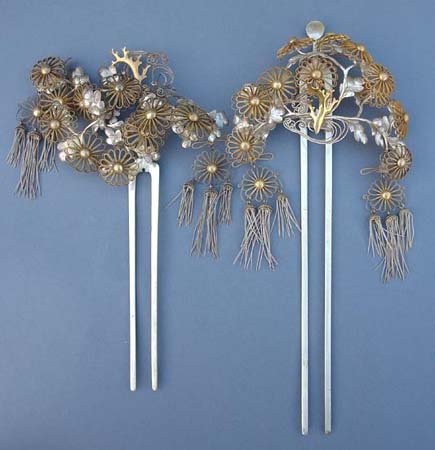This delicately carved blond tortoiseshell comb with 18-karat gold pique, c.1890, sold for $258.88 on Nov. 11. You may refer to Auction #220168340896.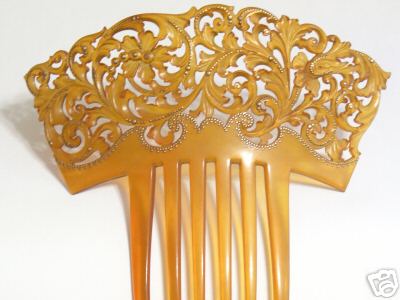
This beautiful blond tortoiseshell hairpin with 14-karat gold decoration and a bar of sapphire and diamonds attached, sold for $229.38 on Nov. 11. You may refer to Auction #220168352193. I thought this one was ridiculously underpriced. I wonder where everyone was.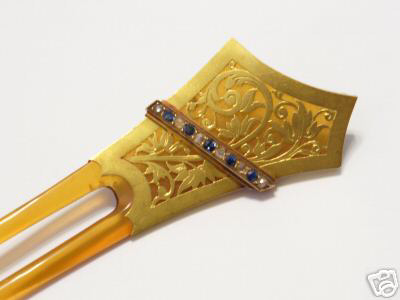
This Meiji gold, silver, and coral bira bira kanzashi went for $305 on Oct. 22. You may refer to Auction #300161851114.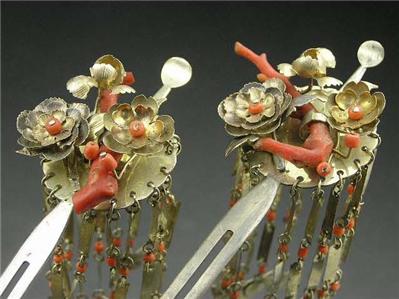
I’m buying this Japanese silver, gold plate, and black enamel Showa set from Shigeru’s brother in Japan. I liked the 3-dimensional quality of it. Lotus flowers in a pool of water.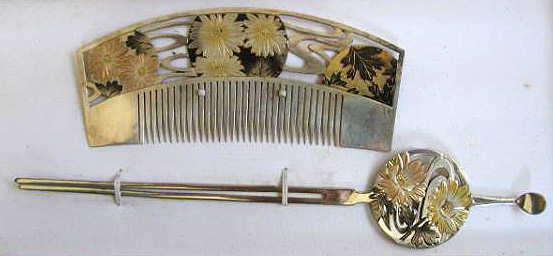
I’m also in installment payments to buy this, a total Barbara piece. It’s Regency, c.1820, a floral spray with rhinestones. One of those flamboyant things I had to have, or I’d die. But it seems I’m that way with everything I love. When the Prince Regent, George, stepped in after his father George III went mad in 1811and then ruled from 1820 – 1830, England named the fashion period, Regency, after him. 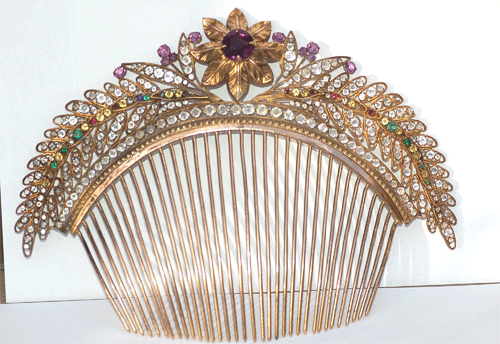
Category Archives: Japanese Hair Comb
Flamboyance
I’m in the mood for the unusual today, so I thought I’d showcase a few combs that are flamboyant variations of the ones we usually see.
These silver and gold kanzashi from the Meiji era are over-the-top attachments to silver pins. They have 16-petal chrysanthemums, leaves, gold branches, and fringe. They were sold on Trocadero for a ridiculous price because I know this dealer. ;-) I didn’t buy them, though. :-(
This tortoiseshell comb boasts 3 carved shell cameos, one of Athena and two of Flora. It sold for $1295 on Ruby Lane, even with two slightly broken tines and a seperation in the scrolled ornamentation at the top. The dealer thought it was French, 1860. I am not sure. With the craze surrounding archeological discoveries that took over Victorian England, it might be English. I’m undecided, but I love it.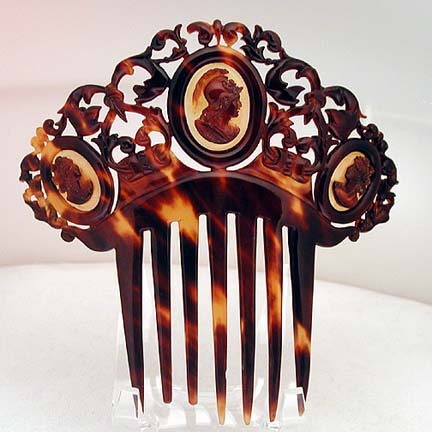
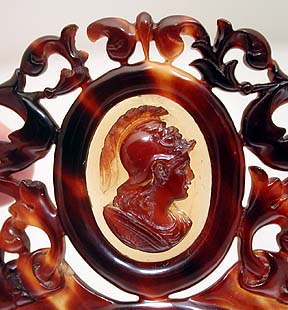
This one I am buying. It’s a Victorian Algerian, c. 1870. As aluminum was discovered in 1827, when this was made, the metal was more valuable than gold. Alas, today, the materials in this comb are worth about 35 cents, but I had never seen one like it, and I had to have it. :-) The leaves are acanthus leaves, after Cesar’s headpiece. The chains are silver, and the beads are turquoise-colored glass. I guess one wore this with a toga-like white gown.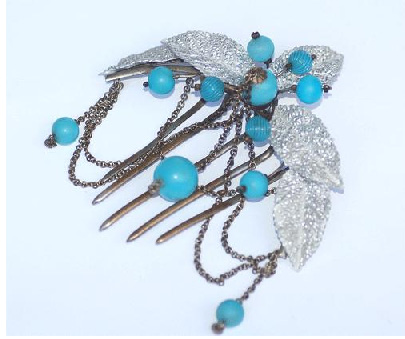
This Edo tortoiseshell comb with a silver- and gold-plated copper frame, decorated with coral beads, sold on ebay for $1000 on Oct 15.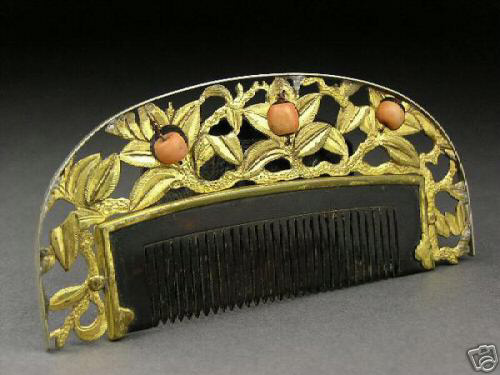
I thought this celluloid comb had humor and originality. It is English, c. 1890, and sold on ebay as part of a 7-piece lot.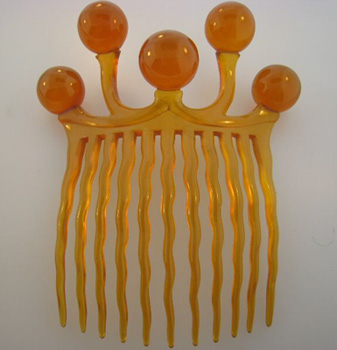
And last, becuase I must, a flamboyant 19th-century tiara of 18K gold with diamonds, emeralds, rubies, amethysts, garnets, and topaz. I loved all the colors. :-) It is available for sale at a jewelry store on Madison Ave. in Manhattan, which was featured in a NOVA special on diamonds, as having one piece of the French crown jewels.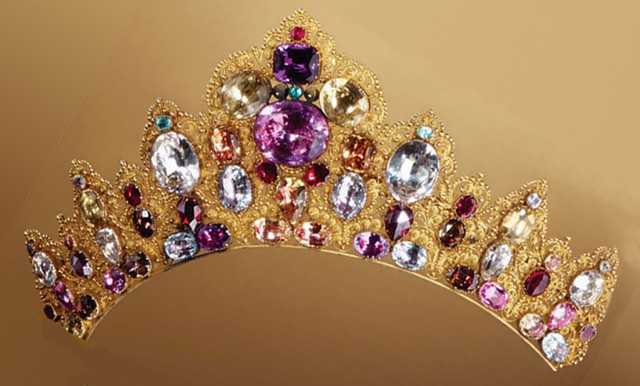
Some Lovely Things on Ebay
There have been some lovely things on ebay recently.
A wonderful 14K gold griffin on a silver base, attached to a tortoiseshell comb sold for $550 on Sept. 27. It has a diamond in its mouth, diamonds on the wings, and a ruby cabachon eye. You may refer to Item #170151496226.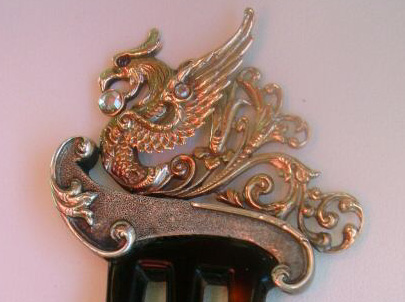

A beautiful Meiji silver-and-gold kanzashi set depicting a bowl, vase, and spoon sold for $465 on Sept. 26. Only one is pictured here so you can see the closeup. You may refer to Item #300153292268.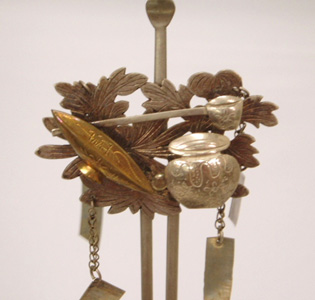
This Victorian garnet tiara hinged on a tortoiseshell comb just sold for $308 on Sept 24. Excellent price for such a lovely star-laden tiara design.You may refer to item #170150463040.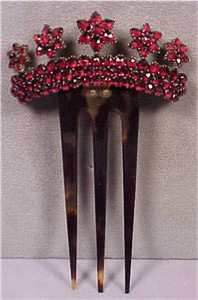
This beautiful Edo kogai stick sold for $660 on Sept 17. It is made of tortoiseshell and decorated with apricot flowers. If you look at the closeup, you can see that little bell flower with the pistels. These painted flowers have the same design as the carved flowers on both shell kanzashi, and the bakelite kanzashi from those Japanese wedding sets they made in the 1940s. You may refer to item #110168679851.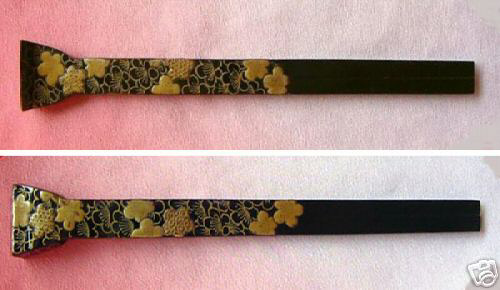
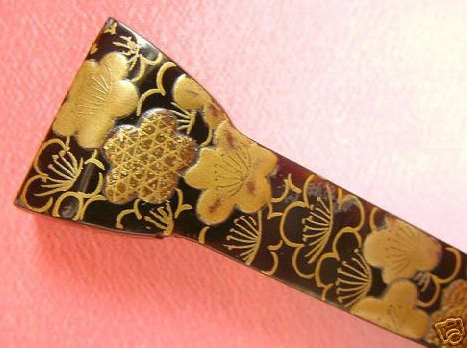
This ivory Edo kogai stick with gold maki-e paint and inlaid jade and coral sold for $300 on Sept. 17. You may refer to Item #330164680560.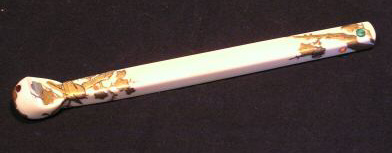
This lovely carved shell floral design on a Meiji set went for $152 on August 30. The stick in between the kogai pieces is wood. There are bug bites on the shell kushi, and that brings the price down considerably. In perfect condition, this would have gone much higher, but I thought $152 was an excellent price for this.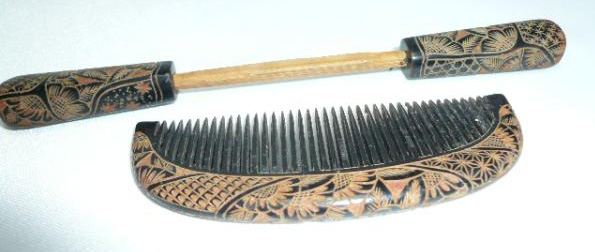
This is a gorgeous piece. The Meiji tortoiseshell kushi depicts waves and is inlaid with pearl. Excellent Condition. It sold for $646 on Sept 22. You may refer to Item #300151918225.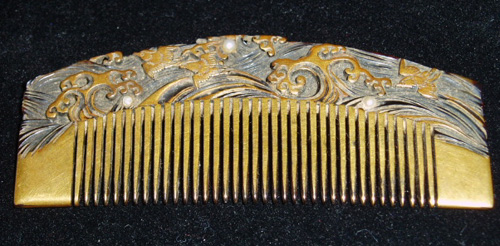
And finally, for today :-), this beautiful Victorian ivory comb sold for $355 (I lost, sadly) on Sept 21. You may refer to Item #290161590846.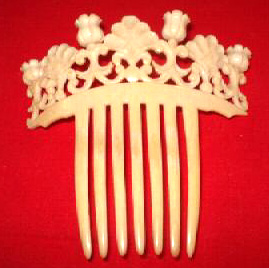
Broken Kanzashi, Broken Heart
Recently, I bought a real shell kanzashi for $214.50. Given the prices Japanese combs are going for on ebay now, I was thrilled to get a real shell kanzashi for a price I could afford. I begged the seller to wrap it properly. I told her a story of when I paid $600 for a real shell kanzashi from Kyoko at Trocadero. It was of a bat. She wrapped it in an envelope, and it came broken. I haven’t been able to find one I liked for what I could afford since then, maybe 3 years ago. Here is what I bought. Shipping cost for me? $14.
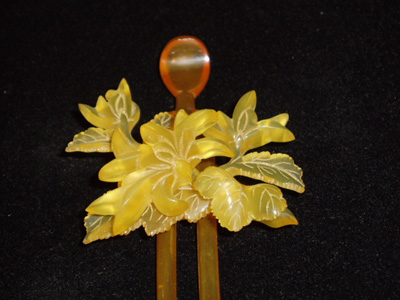
Here is how it arrived: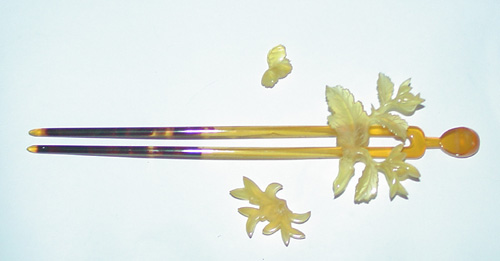
For $14 shipping, it was sent in the smallest-sized priority mail box, wrapped in a few sheets of bubble wrap, with a few popcorn things, and the actual piece was wrapped in what I believe is toilet paper. Sure, I’ll send it back and get a refund, but what the ****. Toilet paper? And a small box, when I begged them? I am just so furious at this moment I could scream. It was a beautiful art piece that survived 100 years in tact. Now, it’s ruined.
Hair Comb Exhibit at the Lalique Museum in Hakone, Japan
After the opening up of trade routes to Japan, Edo combs were introduced at the Paris exhibition of 1867. They took the European art world by storm and began a craze in France called Japonisme . Western artists noticed the strong Japanese relationship with nature, which produced jewelry that was at once delicate and powerful. Rene Lalique was heavily influenced. He chose comb motifs (swallows, hanging wisteria) and materials (horn), which were common in Japan but shunned in Europe at the time.
It is interesting to compare his famous work Two Swallows with a Stalk of Oats c. 1906-1908, carved horn gold and diamonds, with a Meiji kanzashi of plover birds. In Swallows, Lalique takes the Japanese motif to a new level of inventive design and composition. 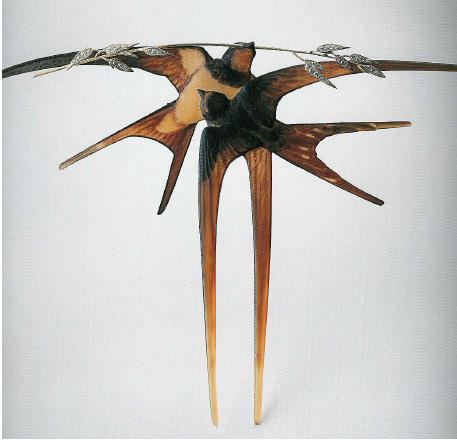
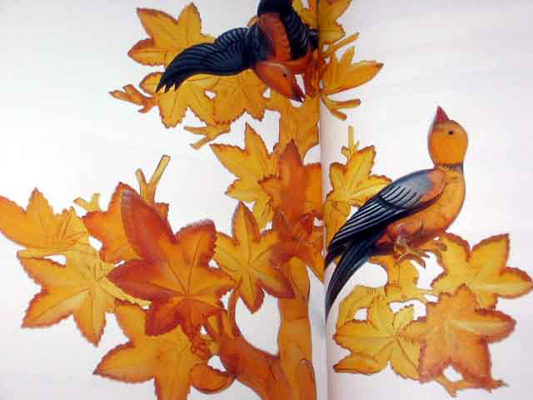
In this comb housed at the RijksMuseum in Amsterdam, Lalique makes Guelder rose flowers on stems of translucent horn. Apparently, they are so fragile that the flowers of diamond clusters seem to be bending the leaves.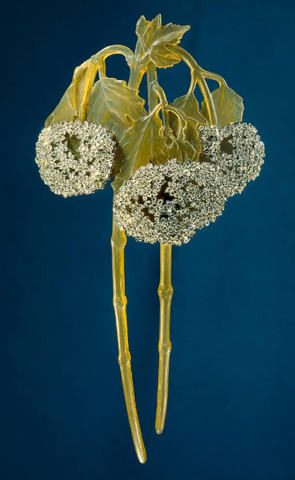
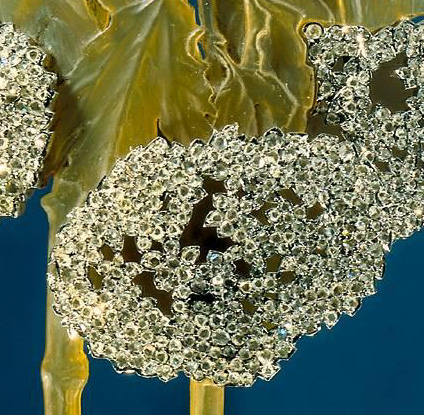
No Lalique post would be complete without an orchid. This one lives in a museum in Lisbon.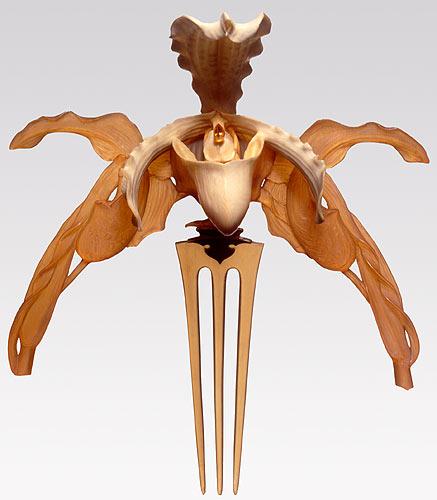
From June 23 to Nov 25 2007, The Lalique Museum in Hakone Japan will have a Special Exhibition: The Charm of Hair Ornaments – Lalique’s Combs and Japanese Traditional Kushi.” I don’t know that these particular pieces will be showcased, but there will be 20 Lalique combs made with his own hands on display. 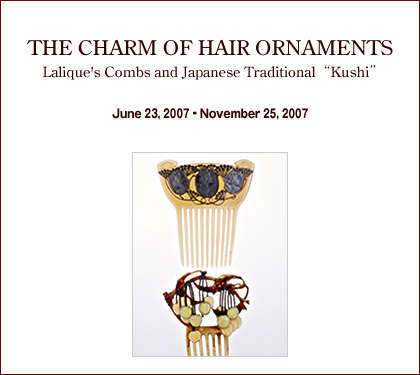
Some Lovely Things on Ebay
Recently, two Japanese sets sold for $950 and $1100, respectively. They were both made of tortoiseshell in the Late Edo period. The first one has a leaf design on the kushi, while flowers rest in a field of grass on the kogai stick. It sold for $950 on July 31. You may refer to Item #330149236404.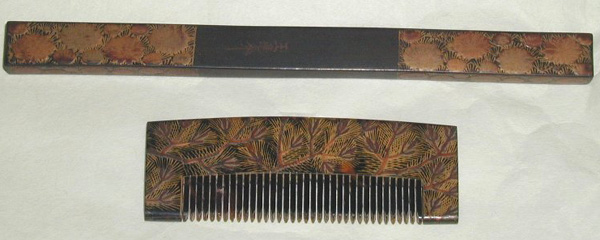
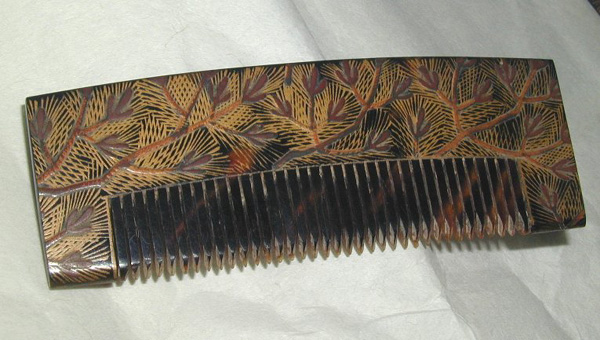
The second set had coral beads set into the kushi and kogai, as the gold maki-e decoration of flowers and leaves almost gives it the look of Imari porcelain. The kogai stick has beautiful gold and silver mounts that attach the oramental shell pieces to the stick itself. It sold for $1100 on August 2. You may refer to item #300135266043.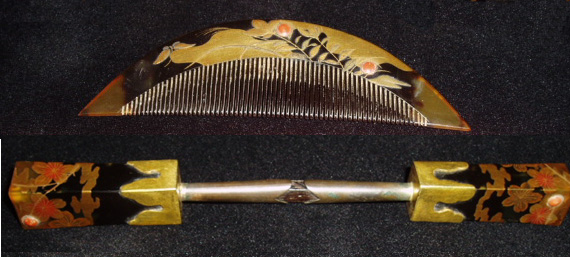
This beautiful Sterling silver comb with filigree leaves sold for $260 on July 30. I think it might be French, but I’m not sure. Comments welcome on this. I thought the design was distinctive and well balanced. You may refer to Item #160140008982.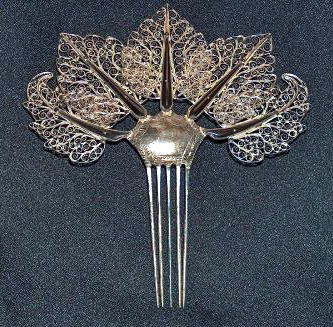
And finally today, I’ll show a comb a friend gave me pictures of. The dealer who showed it to her wanted $1200, and she is still undecided. It’s a beautiful Japanese Sterling silver, signed comb with a fish swimming in the water. Looking at the shape and size, I think it’s Meiji, although the design — one idea, and a fish — harks back to the Edo period. Comments welcome on this.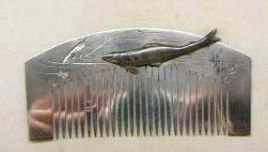
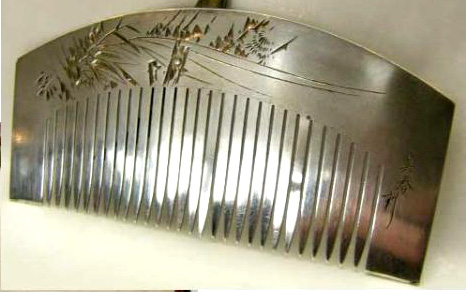
Some Lovely Things on Ebay
There have been some lovely silver and coral kanzashi selling for excellent prices on ebay. Very unique objects, such as a man-with-hat and an instrument, were attached to the hairpins. The Meiji man-with-hat went unsold at $350, whereas the Edo kanzashi of a Japanese traditional instrument with fish carved into the hairpin itself sold for $390. The shell bird kanzashi with gold makie went for $293. 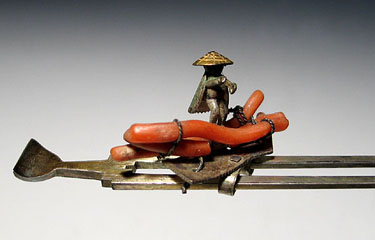
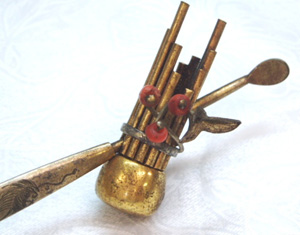
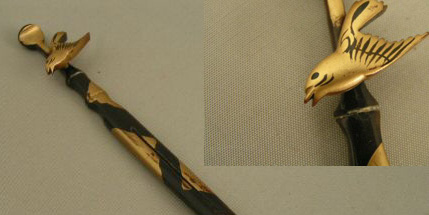
Two elaborately carved Meiji tortoiseshell kushis also sold, but at very different prices. The first one had a complex design of fans and flowers, no bug bites, and was signed. The second one had an elaborate floral design of chrysanthemums and peonies, a few bug bites, and was not signed. There was a significant price differential. Kushi #1: $577 on July 14; Kushi #2: $127.50 on July 15.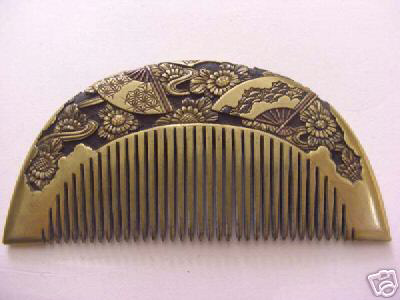
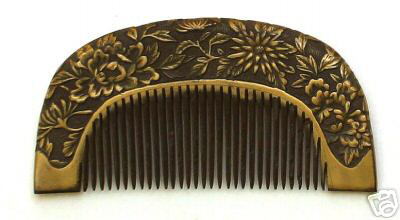
There was also a lovely brass Victorian tiara, which went unsold at a starting bid of $275.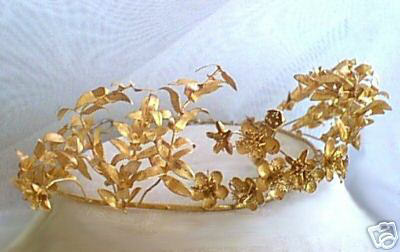
A beautifully balanced design marks this lacquer over shell signed Meiji set, which sold for $283.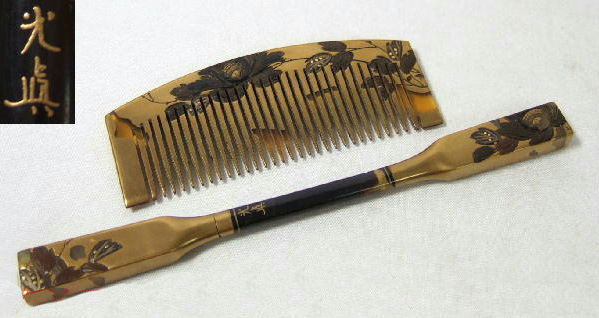
And I will end this post with two more museum-quality blond tortoiseshell kanzashi ornaments of plover birds flying over the sea.
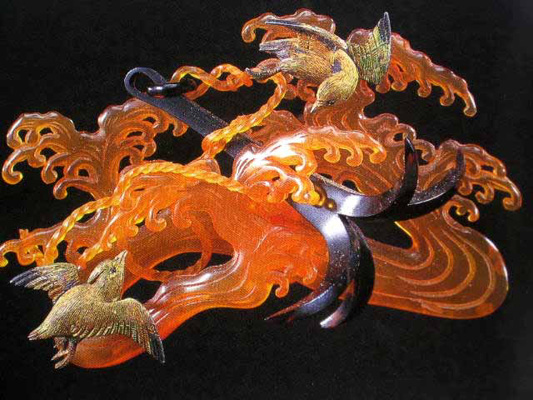
The One That Got Away
I saw it listed at $9.99, 6 days to go. It was a drop-dead gorgeous real shell kanzashi with coral. I thought it was real, anyway. My eyes popped out of my head. I emailed two of my friend collectors. “Are you going for this?” “Do you think it’s real?” The coral is too pink, but it looks real. All of us thought it was real, so I put a large snipe bid on it.
I thought to myself, I could write to this person, ask them to end the auction, play games, but I just am not in that space anymore. The grab, the manipulation of someone who doesn’t know as much as you, the seduction to get the coveted item at a low price.
The whole dance makes me vomit. I couldn’t do it, but I saw this seller’s vulnerability. I mean she was the kind of n00b, who lists a priceless piece and then makes sure people know they don’t get the pillow it’s pictured on as a part of the auction. I am going to value this at around $700. A similar pair of shell kanzashi went for $890 on Trocadero, recently. Comments welcome if you disagree.
In addition to listing it at $9.99 with no reserve, this seller stated she didn’t know what she was doing, that her father left this to her, which means he gave it to her with love, which means it’s real, which means… The (0) next to her name told us it was the first time she was listing on ebay. She was bait for the vultures. I put a snipe bid on it that reflected what I thought was its real value and said nothing.
One day before auction end, the item was gone. Someone wrote to her and convinced her to sell them the item off ebay. I don’t know what they said. I don’t know what kind of value she got. I hope she wasn’t a meal for some dealer, and we don’t see this piece on someone’s site going for full value in the near future. If we do, then I guess we’ll know who the vulture was.
And then the question for all collectors becomes, you either win the game or you don’t. You either get the coveted piece or you don’t. Do you want to do what it takes to win? What will it do to you as a human being? It’s not in me anymore. So ah well, the one that got away.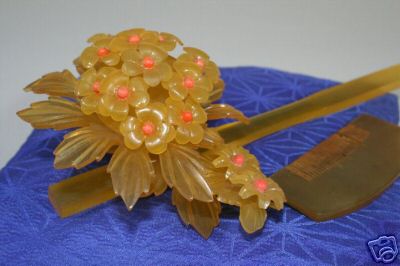
To Delight The Eye
I liked these. :-)
Edo comb, possibly Japanese hibiscus? 18th century.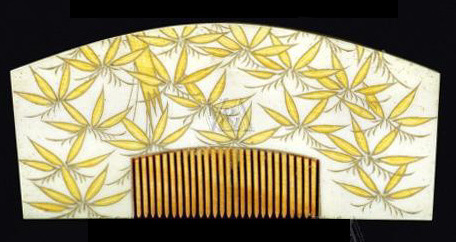
Liturgical comb of Boxwood inlaid with geometric marquetry & studded with silver. Italy, c.1500. The Italians were world renowned for intarsia wood craft during this period, the most famous example being The Gubbio Stuiolo at the Metropolitan Museum of Art.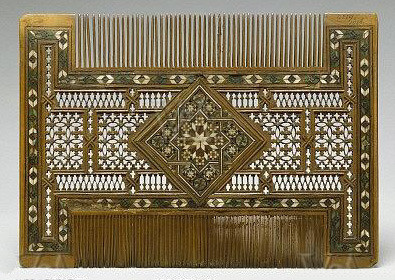
Here is a tiara from Rene Lalique, 1903-1904.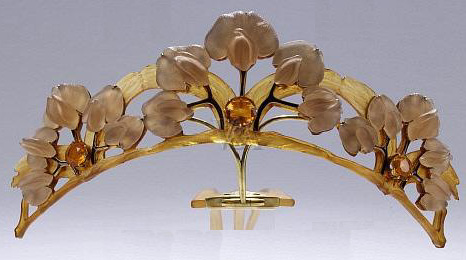
This is a lovely tortoiseshell comb by Alexander Parkes, England. c. 1870.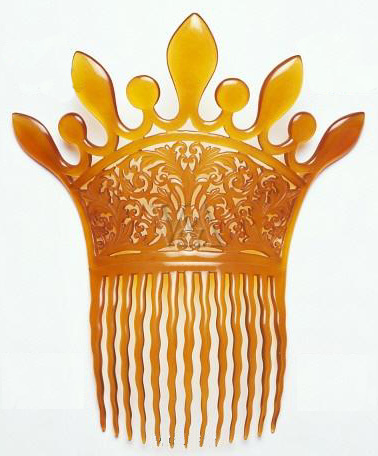
This winged ornament sat atop a tiara, which would be worn to the opera, perhaps a performance of Wagner “Die Walkure” (The Valkyrie). It is made of tortoiseshell, diamonds and pearls. France. c. 1900. 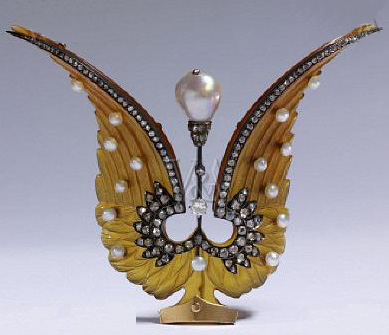
And finally, because I must… ;-) An English rose-cut diamond and pearl tiara, c. 1860. To die for. :-)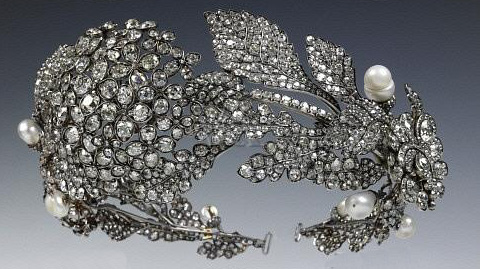
C’est la vie, peeps! Have a great month. :-)
Well, you had to wear them in something
Here are some 19th-century paintings of Geishas in their wigs, wearing the beautiful ornaments we all admire. It’s nice to see kushi and kanzashi in context. From the historical record these paintings provide, it looks like the wigs were just as creative as the combs.
Geisha with Sake Cup, by Keisai Yeisen (1789-1851)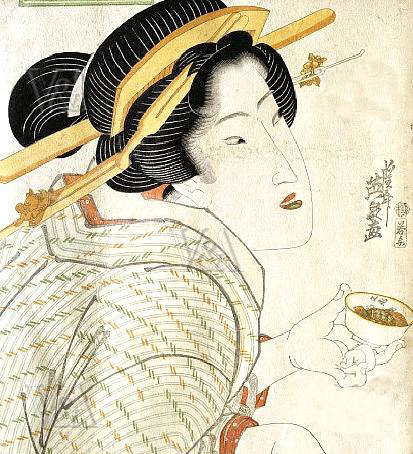
Courtesan with a fan, by Kitagawa Utamaro (1753-1806)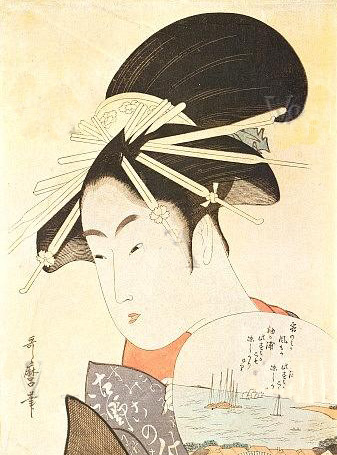
The Doll’s Festival, from the Furyu Goyo Matsu (Five Seasonal Festivals) Series, by Torii Kiyomitsu II (Torii Kiyomine) (1788-1868)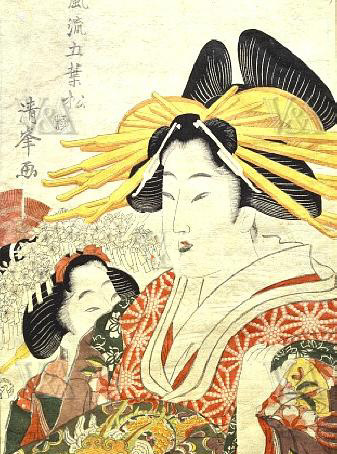
Beauties of the Yoshiwara at Daikoku House, by Keisai Yeisen (1789-1851).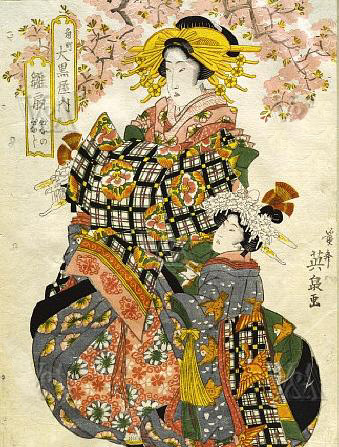
And on a BA-Life Personal Clutz Note: I’m glad my Japanese combs are in a case. Can you imagine balancing in one of those wigs, knowing you have these priceless tortoiseshell ornaments on, and you can’t fall? And the kimonos! Can you imagine walking in that and not falling? Who stopped wearing heels at 40? ;-)

